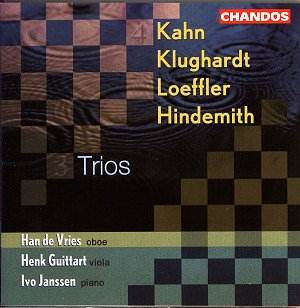One of the most rewarding areas of chamber music is the repertoire
that mixes the various instrumental families, as here, for example with
woodwind, strings and keyboard. It will come as a surprise to many music
lovers that there is enough worthwhile music for the slightly odd combination
of oboe, viola and piano to fill an entire CD, but I can assure you that
there’s plenty more! However, the works on this disc have been carefully
selected to achieve a pleasantly contrasted programme, though inevitably
the quality of the music is uneven.
Not surprisingly, it is the Hindemith Trio which is
far and away the most interesting piece, and it is in fact one of his
most fascinating and personal small chamber works. Hindemith is, in
many senses, the Telemann of the twentieth century. He wrote so much
music, and with such improbable facility, that it’s too easy to
assume that none of it is much good, and thus to dismiss him as a talented
hack. This is wildly misguided, for Hindemith was a true genius, with
a brilliantly disciplined mind, a master of that peculiar kind of lateral
thinking we call musical composition. He had an unmistakable voice,
and a highly personal style, which, once you get over its initial acerbity,
is full of beauty and inventiveness.
The trio has two particularly unusual aspects to it;
one is its two-part structure, the first part running continuously,
though in 3 sections – Solo, Arioso and Duett – while the second is
a series of four short movements. The other striking feature of the
piece is the use of the heckelphone, a type of baritone oboe, and quite
a rarity outside the works of Richard Strauss. In the capable hands
of Han de Vries, it proves to be an expressively plangent soloist. In
Part 1, Hindemith begins with the piano solo, adds the heckelphone for
the Arioso, completing the ensemble with the viola in the Duett.
Part 2, ‘Potpourri’, explores the possibilities of the combination
in four linked sections. The texture is involved and contrapuntal, culminating
in a final breathless Prestissimo. The trio give a finely judged
performance of this terrific little work, with the various tempi beautifully
‘geared’ to each other, though it’s a pity about the ragged final note.
The other works on the disc are not on this artistic
level, though Kahn’s Serenade is a charming little piece, in one continuous
movement though, like the Hindemith, in clearly defined and contrasted
sections. Then follow two works inspired by poetry; August Friedrich
Martin Klughart’s Schilflieder – literally ‘Reed Songs’ – is
based on a series of poems by Lenau, typical, in their way, of German
Romanticism, full of Nature and Lost Love and Pierced Souls. Sometimes
the music’s connection with the poetry seems tenuous; hard to see what
the passionate, almost heroic second movement has to do with the lugubrious
poem it relates to. The third movement, however, which is also the longest,
develops touchingly into a restrained, sad song for the three instruments.
Loeffler’s Two Rhapsodies after poems by Maurice Rollinat
are rather more convincing. The poem behind the first one is called
‘The Pond’, and Loeffler treats it very simply and expressively. The
second, ‘The Pipes’, is more agitated and complex, using the plaintive
tones of oboe and viola effectively.
The three musicians play beautifully, with immaculate
tuning, expressive phrasing, and excellent ensemble, and the recording
captures them well. I sometimes wished, though, for more assertive viola
playing from Guittart, and de Vries sounds a little tense and tentative
in his softer passages. The result is that the music is well played
but a little under-characterised in places, especially as some of it
is in need of considerable advocacy.
Gwyn Parry-Jones


